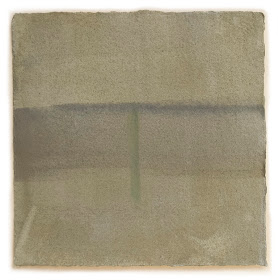Noh Costume (Nuihaku) with Scattered Crests; Japan, Edo period, second half of 18-19th century; silk embroidery and gold leaf on silk satin; overall 65 x 53 1/2 in.
Each time I see a show of Japanese art and objects I am more convinced that the culture had a genius for design; whether in
prints, or with the
Rinpa aesthetic, or
paintings of birds, there is an unerring use of shape and line to animate a surface; it is no wonder that Japanese art was so influential in early Western modernism. The latest treasures are to be found in an exhibition at the Metropolitan Museum of Art:
"Kimono: A Modern History". Robes from the late 18th century up until the 20th century are included, with accompanying objects, all of which can be seen at the link. The circular crests, some of which have Buddhist meanings, seem to be spinning across the white glistening silk of the Noh costume.
detail Noh Costume (Nuihaku) with Scattered Crests
I was very naughty the day I was at the Met; there were so many very beautiful objects that we weren't supposed to photograph, but my eye itched to capture them, so I snuck photos in this and in another show. The photos of professional photographers are too often flooded with light, flattening the objects (and even paintings) and bleaching them of life. So, this photo that I took gives a better sense of the physical presence of the design of the kimono.
detail, Noh Costume (Karaori) with Court Carriages and Cherry Blossoms; Japan, first half 19th century; twill-weave silk brocade with supplementary-weft patterning in metallic thread.
See the entire garment
here.
This is another richly embroidered kimono with a complex pattern, a complete delight to wander through.
detail Outer Robe (Uchikake) with Mandarin Oranges and Folded-Paper Butterflies
I love the varied approaches to the materials in this robe. The whitish line of a tree and its leaves are made with tie-dyeing; the other elements are embroidered. It is incredibly beautiful.
Outer Robe (Uchikake) with Mandarin Oranges and Folded-Paper Butterflies; Japan, late 18th-early 19th century; tie-dyed satin damask with silk embroidery and couched gold thread; overall 69 1/2 x 48 1/2 in. Image courtesy
Metropolitan Museum of Art.
Of course a robe like this was for an elite person, a high-ranking samurai woman. An outer robe such as this was worn for a traditional wedding: the folded male and female butterflies symbolizing the wedded couple, and a long and happy marriage.
Tsujigahana Textile with Horizontal Stripes, Flowering Plants, Fans, Snowflakes, Clouds, and Bellflowers; Japan, Momoyama period (1573-1615; plain weave silk with resist dyeing and ink painting; 24 3/16 x 15 1/2 in.
detail Tsujigahana Textile
There are lovely design variations in the horizontal bands of this textile. In the detail, which I downloaded from the enlargement at the Met's website, you can see (click to enlarge) how some of the patterns were made by resist dyeing, such as the small squares with the dark central dot which also appear in the Outer Robe above.
Dancers; Japan, Edo period, late 17th-early 18th century; six panel folding screen; ink, color, and gold on paper; 50 3/16 x 136 5/16 in.
The graceful movements of dancers in their elegantly patterned robes float on a golden ground.
Farmer's Jacket; Japan, second quarter of 20th century; plain-weave cotton, silk, and mountain wisteria fiber (yamafuji); 47 1/2 x 51 in.
Not all the garments in the show were for high ranking individuals. There were several dramatic firemen's jackets and this lovely, restrained farmer's jacket, woven from scraps of used textiles. It is believed to have belonged to a successful farmer and was likely never worn.
Kosode Pattern Book, vol. 1; Japan, 1667; ink and color on paper, 7 x 5 in.
I loved seeing these old patterns with their very dynamic designs. There are 12 double pages at the link above, all creating a sweeping movement across the surface of the
kosode, or robe.
Unlined Summer Kimono (Hito-e) with Swirls; Japan, ca. 1920-30; crepe silk gauze, 60 13/16.
When we come to the kimono of the 20th century the designs become bolder and more abstract, very much influenced by the art and design of the times, including Western art. The green and white swirls of this piece are dizzying and quite thrilling.
Meisen Kimono with Geometric Patterns; Japan, 1920s; plain-weave raw silk, stencil-dyed warps and wefts; 57 1/2 x 47 3/16in.
Unlined Meisen Summer Kimono with Cracked-Ice Pattern; Japan, 2nd quarter of 20th century; plain-weave raw silk, stencil-dyed warps; 55 1/2 x 50 in.
The Met's website wasn't very helpful as to what
Meisen kimono were, so a little research turned up the fact that the meisen textile is woven of second grade silk threads in the Kanto region. They were kimono that had modern all-over designs and were available to ordinary people: they weren't made to order but were sold off the rack in Japan's new department stores and were very popular with young women.
Chichibu Meisen Kimono with Multicolor Checks; Japan, 2nd quarter of 20th century; silk ikat; 59 1/16 x 49 3/16.
Meisen Kimono with Overlapping Circular Patterns; Japan, first half of 20th century; raw silk, stencil dyed warps and wefts, 59 x 49 1/4 in.
These kimono are so wacky and wonderful, with their exuberant color and design. They were made up until the mid 1950s, when Westernized clothing took over. From the highly specialized and individualized kimono of earlier times, garments that spoke of the wearer's status, to more open and modern ones, all were beautiful, and all induced a feeling of longing; longing for beauty in items of everyday life.



















































